Alexander Hamilton arrived in America in 1772 at the age of fifteen—a poor, self-taught, ambitious immigrant from the West Indies. He settled in New York City in the midst of the colonial crisis, when oppressive taxes and other policies pushed Americans to question British rule. Hamilton soon befriended prominent patriots and embraced the cause for independence in his adopted country.
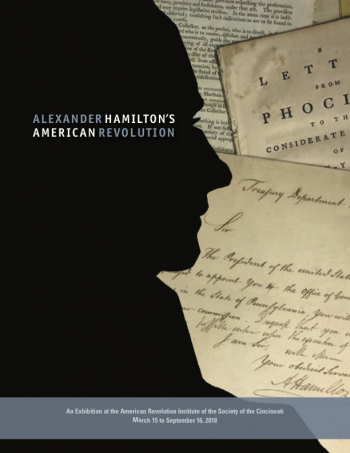
Click to download the catalog.
The American Revolution was a defining event in Alexander Hamilton’s life and influenced his vision for the nation. He fought the Revolutionary War as an energetic but inexperienced private in a volunteer militia unit, a battle-tested commander in the Continental Army, and the principal aide-de-camp to General George Washington. These experiences convinced Hamilton that the new nation needed a strong central government and national institutions in order for the union of states to survive. Hamilton was an important and unwavering force in the political revolution that produced the U.S. Constitution and the American form of government, ensuring that the ideals he had fought for would endure.
After the war, Hamilton became an original member of the Society of the Cincinnati, an organization of veteran officers founded in 1783 to ensure that the principles of the Revolution and the sacrifices required to win American independence would not be forgotten. He believed that the Society—one of the few national organizations in the young country—was a valuable force for securing the future of the American republic. Hamilton led the Society as its second president general—an office first held by Washington—until his untimely death in 1804.
Alexander Hamilton’s American Revolution tells these stories through nearly forty manuscripts, rare books, artifacts and works of art drawn primarily from the Institute’s collections. The exhibition also includes important loans from Georgetown University, Hamilton College, the New York State Society of the Cincinnati and several private collections.
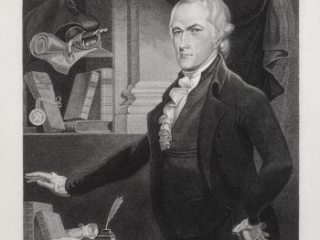
Alexander Hamilton, Major General of the Armies of the United States of America, Secretary of the Treasury, &c. &c.
William Rollinson, engraver; after Archibald Robertson, artist
New York: Published at the Columbia Academy of Painting, 1804The Society of the Cincinnati, Purchased with a gift from a private foundation
This stipple engraving published just a few months after Hamilton’s death celebrates his wide-ranging contributions to the new American republic. It pictures symbols of his public service, including the seal of the Treasury Department, a sword and cockaded hat, and the Society of the Cincinnati Eagle insignia.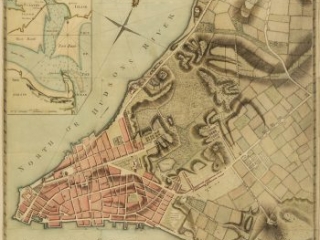
A Plan of the City of New-York & its Environs
John Montrésor, cartographer; Peter Andrews, engraver
London: Sold by A. Dury, 1775The Society of the Cincinnati, The Robert Charles Lawrence Fergusson Collection
Alexander Hamilton first set eyes on New York City in October 1772 and entered King’s College (now Columbia University) a year later. The school was located one block west of the Common at the northern edge of the city—labeled with the letter N and identified as the “Colledge” on this plan of the public buildings and military sites in and around New York.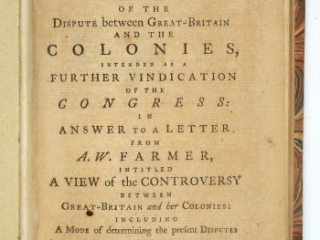
The Farmer Refuted: Or, A more impartial and comprehensive View of the Dispute between Great-Britain and the Colonies
New-York: Printed by James Rivington, 1775The Society of the Cincinnati, The Robert Charles Lawrence Fergusson Collection
This is the second of Hamilton’s early political essays arguing for American self-governance. Published anonymously, these pamphlets were responses to pro-British essays penned by a loyalist, Samuel Seabury, who wrote under the pseudonym “a Farmer.” These writings established him as one of the leading voices of the American cause and one of the best essayists in the colonies.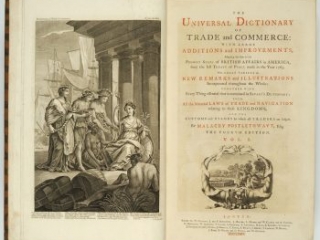
The Universal Dictionary of Trade and Commerce
Malachy Postlethwayt
London: Printed for W. Strahan, 1774The Society of the Cincinnati, The Robert Charles Lawrence Fergusson Collection
During the Revolutionary War, Hamilton read and took notes from numerous military, political and economic texts. This indispensable resource on the political, legal and financial aspects of trade and commerce in the British empire came in two volumes weighing a total of twenty-five pounds.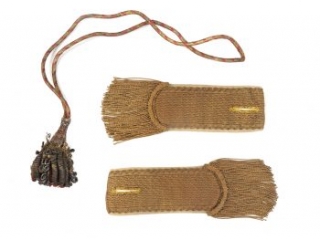
Field epaulets and sword knot
Probably American
Late 18th centuryThe Society of the Cincinnati, Museum purchase with funds donated by the New York State Society of the Cincinnati and The Robert Charles Lawrence Fergusson Fund, 1991
Hamilton is said to have worn this pair of field epaulets and sword knot—a device for securing a sword to an officer’s hand——during the Revolutionary War.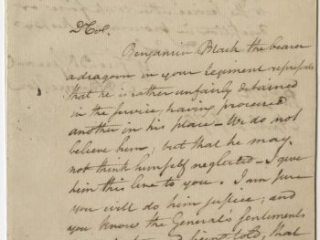
Alexander Hamilton to Stephen Moylan
April 21, 1779The Society of the Cincinnati, Gift of Evelyn Lansdale Wildman and Clare Lansdale Johnston, 1977
Hamilton served as aide-de-camp to George Washington for four years during the Revolution. During that time, Hamilton wrote this letter to Colonel Stephen Moylan, commander of the Fourth Continental Dragoons, advising him on retaining soldiers in regiments.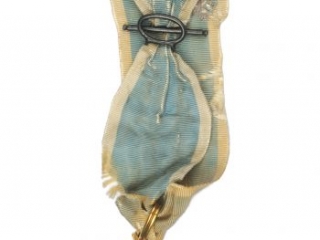
Society of the Cincinnati Eagle insignia owned by Alexander Hamilton
Nicolas Jean Francastel and Claude Jean Autran Duval, Paris
1784Private collection
Hamilton owned this insignia of the Society of the Cincinnati, known as the Eagle. It was one of the first examples made in Paris in early 1784 under the direction of Pierre L’Enfant, who designed the badge. The double-sided gold badge bears enamel decorations.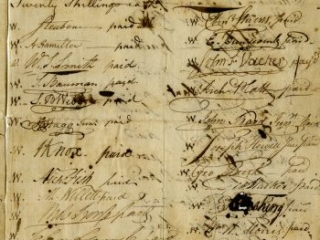
“Subscription List”
July 4, 1789Collection of the New York State Society of the Cincinnati
The New York State Society of the Cincinnati’s annual meeting on July 4, 1789, ended with a dinner at the City Tavern in New York City. Seventy men from several different branches of the Society signed this subscription list to attend, including Hamilton, Steuben, L’Enfant, Henry Knox, Nicholas Fish, Robert Morris and Arthur St. Clair.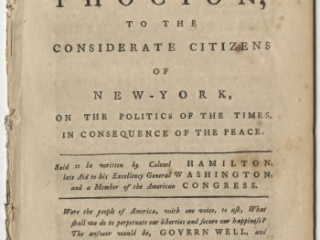
A Letter from Phocion, to the Considerate Citizens of New-York on the Politics of the Times, in Consequence of the Peace
Philadelphia: Printed and Sold by Robert Bell, 1784The Society of the Cincinnati, The Robert Charles Lawrence Fergusson Collection
The mistreatment of loyalists after the Revolution inspired Hamilton to write this essay, urging his fellow New Yorkers to end the attacks on their former enemies. Hamilton considered the mistreatment unlawful and unethical, and an example of the dangers of the breakdown of law and order into mob rule.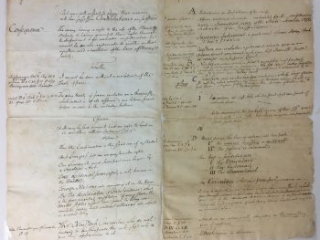
“Rutgers v. Waddington”
Alexander Hamilton
1784Burke Library, Hamilton College
In June 1784 Hamilton served as the defense attorney for a loyalist, Joshua Waddington, who was being sued by a patriot widow for back rent on her family’s brewery in New York City while it was occupied by the British. Hamilton wrote his arguments on these pages, citing the law of nations and the peace treaty with Britain.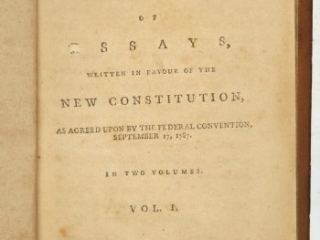
The Federalist: A Collection of Essays, Written in Favour of the New Constitution.
New-York: Printed and Sold by J. and A. M’Lean, 1788Rare Books, Booth Family Center for Special Collections, Georgetown University
To explain the U.S. Constitution and urge its ratification, Hamilton organized the production of eighty-five essays, first published in New York newspapers. This monumental work of American political thought written by Hamilton, James Madison and John Jay was compiled into the first bound edition in the spring of 1788.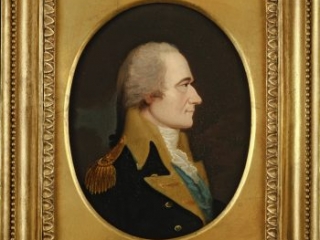
Alexander Hamilton
William J. Weaver (ca. 1759-1817)
ca. 1806The Society of the Cincinnati, Museum Acquisitions Fund purchase, 2016
Hamilton wore a uniform like the one depicted in this oil-on-wood panel portrait as a major general in the U.S. Army during the Quasi-War of 1798-1800. The artist painted versions of this posthumous portrait for Hamilton’s friends and admirers.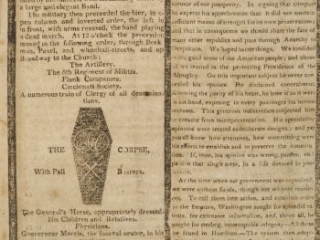
New-York Herald
July 18, 1804The Hamilton Newspaper and Ephemera Collection of Antonia Chambers Esq.
Two days after Hamilton died from wounds sustained in the duel with Aaron Burr, the New York City Council hosted his funeral procession, eulogy and burial. The New York State Society of the Cincinnati organized the funeral, and its members marched just before the casket in the procession. Newspapers across the country printed accounts of the event, often with black borders around the pages and columns to honor “this mournful occasion.”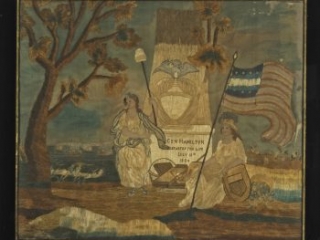
“Hamilton’s Tomb”
Catharine Tuttle Young
1811The Society of the Cincinnati, The Robert Charles Lawrence Fergusson Collection
Catharine Tuttle, a young schoolgirl in New Jersey, worked this silk embroidery in October 1811 to mourn Hamilton’s death. The scene was based on an engraving issued by John Scoles. It depicts figures of America and Liberty flanking his tomb, with symbols of his service on the ground.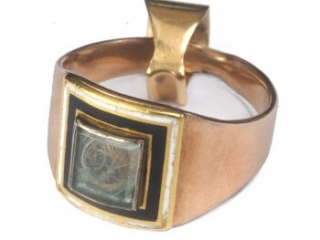
Mourning ring
American
ca. 1804Private collection
Alexander Hamilton’s widow, Eliza, wore this gold mourning ring for fifty years. A lock of Alexander’s hair rests under the glass, while inside the band an inscription reads, “Alexander Hamilton / Ob: July 12th 1804. / Ae: 46 yrs. 6 mos.”